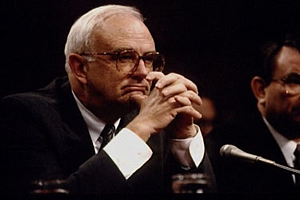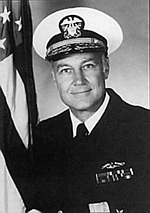 |
|
Former defense secretary Les Aspin
envisioned a radically different U.S. nuclear posture. |
The 1994 Nuclear Posture Review
(Nuclear Brief July 8, 2005)Secretary of Defense Les Aspin announced
on October 29, 1993, the start of a comprehensive review of America's
nuclear posture. The Nuclear Posture Review (NPR) was described as "the
first DOD study of its kind to incorporate reviews of policy, doctrine,
force structure, operations, safety and security, and arms control in
one look."
Building on the defense vision of the Bottom Up Review (BUR)
completed on September 1, 1993, the NPR was intended to focus on the
deterrent (rather than warfighting) capabilities of nuclear weapons. But
since warfighting capabilities are seen as inherent elements of a
credible deterrent, this noble intention quickly faced massive
opposition from the military services and hardliners.
Other interests, such as maintaining as
many weapons as possible and ensuring funding for existing programs, as
well as general uncertainty over where the world war heading after the
Cold War, combined to doom the NPR from the outset. These difficulties
were compounded by the wide gap in the vision of the political
leadership that pushed for the review and the military that would have
to implement it. The result was a review that created a "nuclear lite"
scaled-down Cold War posture rather than the fundamentally altered
nuclear posture envisioned by its mentors.
The Process
The review was a "DOD-wide collaborative
effort" lead by a five-person steering group co-chaired by Ashton
Carter, the Assistant Secretary of Defense for Nuclear Security and
Counterproliferation, and Major General John Admire, the Vice Director
for Strategic Plans and Policy at Joint Staff. The other three members
represented nuclear, space, and intelligence agencies.
The review was organized around six
topics, with each topic examined by a team of military and civilian
experts from the DOD, Joint Staff, the Services and various agencies.
The six topics were:
1. The role of nuclear weapons in
U.S. security strategy.
2. U.S. nuclear force structure.
3. U.S. nuclear force operations.
4. Nuclear safety and security.
5.
The relationship between U.S. nuclear posture and
counterproliferation policy.
6. The relationship between US nuclear posture and threat reduction
policy with the former Soviet Union.
The overall objective for the six working
groups was to define the issues, analyze the options, prepare
recommendations, and to prepare implementing documents. The schedule for
the review envisioned that the working groups would finalize their
recommendations by late spring 1994. The Secretary of Defense would then
submit a final report to the President in June 1994. The elaborate NPR
study process was intended to produce several specific products,
including a new Presidential Decision Directive (PDD) to "replace" two
outdated presidential directives:
1. National Security Decision
Directive (NSDD) 13 on nuclear employment policy signed by Ronald
Reagan in 1981.
2. Presidential Decision (PD) 48 on ballistic missile submarine
commitments to NATO, signed by President Jimmy Carter in April 1979.
The new PDD, in turn, would have
triggered production of two revised military guidance document: the
Nuclear Weapons Employment Document (NUWEP) and Annex C (nuclear) to the
Joint Strategic Capability Plan (JSCP). (go
here for JSCP description)
NPR Infighting
 |
|
STRATCOM saw Ashton B. Carter's views in the NPR
as "an uphill battle." |
From the beginning of the review, the
military viewed Ashton Carter with skepticism. STRATCOM had collected
background information on Carter that indicated "a less-than favorable
tong-term outlook for nuclear weapons” and long-term visions of
"complete denuclearization." The nuclear command was concerned that
persuading such policy makers of a continued need and "wider role" for
nuclear weapons would be "an uphill battle." Carter made his view clear
in May 1994 -- in the middle of the NPR -- in an interview with Los
Angels Times:
"Out intention is to have a military
that doesn't need to use [nuclear, biological, and chemical]
weapons. We can use conventional forces to prevail anywhere in the
world."
After only a few months of work, one of
the two co-chairs (Maj Gen John Admire) sent a
letter to Ashton Carter in which he expressed concern with the NPR
process and how the Steering Group would review and approve the working
group findings. This same concern, he said, "has been expressed to me by
the Services and CINCs based on input from their working group members."
Four days later, Carter issued a
joint letter with Admire to the NPR Steering Group that outlined the
"way ahead." The Steering Group's activity would intensify, the letter
said, and laid out a work plan for the six working groups that aimed at
completing a preliminary draft NPR guidance by mid-February.
The letter immediately triggered an angry
memo within STRATCOM, which complained over the lack of progress and
tight schedule. Retired Admiral Bobby Inman complained to STRATCOM chief
Admiral Henry Chiles that Carter's plan "imposes a schedule that will backfill
the vacuum with grab-bag thinking and then ask the Secretary for his
blessing….This would be comical if we didn’t have so much at stake."
At stake was the nuclear mission of two
of the three legs in the Triad: ICBMs and bombers. In May 1994,
Inside the Air Force reported that Carter had proposed a Monad
concept -- apparently against the recommendations of the NPR steering
group -- that would retire all ICBMs, denuclearize all bombers, and
leave the remaining strategic nuclear warheads on only ten strategic
submarines. Only 1,550 warheads would be deployed.
 |
|
STRATCOM commander Admiral Henry Chiles opposed
Ashton Carter's plan to end the Triad. |
In response to Carter's proposal, the
military quickly organized its counteroffensive. In a joint letter to
the Joint Chiefs of Staff Director, the Air Force, Navy, Army, and
Marine Corps complained that Carter had pushed his own Monad idea
instead of following the recommendations of NPR Working Group 2. Word
quickly reached Capitol Hill where opponents to changing the nuclear
posture too much joined the battle with statements made from the Senate
floor and letters sent to the President. And on April 20, 1994, STRATCOM
commander Admiral Chiles testified before the Senate Armed Services
Committee that although he did "not want to pre-empt the review's
conclusions," he did so anyway by stating that "the Triad [bombers and
land- and submarine-based missiles] concept remains appropriate."
In the end, Carter's academic vision and
elaborate study plan could not match the technical and bureaucratic
skills of the military services. According to one civilian participant
in the review: "The military officials knew the lay of the land, we
didn't. Ash Carter set us up for disaster."
The NPR Outcome
After the April-revolt, the working group
efforts collapsed in the early summer of 1994. Rather than waiting for
their conclusions, Admiral Chiles asked his
Strategic Advisory Group (SAG) to prepare a paper that described
what the nuclear posture should look like. The six-page document "Nuclear
Forces; Post 1994" outlined the main policy and force structure
assumptions and appears to have strongly influenced the final NPR
decision.
Chiles didn't keep the paper within
STRATCOM but forwarded it to JCS Chairman General Shalikashvili, who
said the paper would be useful as the Joint Staff evaluated the
conclusions and recommendations on the NPR. "In particular,"
Shalikashvili said, "I appreciate your perspective on hedging against
future uncertainty while we grapple with near-term resource
requirements." Chiles subsequently thanked the SAG and said the paper
has been "particularly effective" in preparing the NPR.
When the Pentagon released the final
conclusions of the NPR on September 22, 1994, the result was a
combination of STRATCOM's
Sun City and
Sun City Extended force structure studies from 1993, and the
1994 SAG paper's recommendations. The force structure contained the
following:
|
Bombers: |
20 B-2s, 66 (later changed to
76) B-52s, and non-nuclear role for B-1s |
|
SSBNs: |
14 SSBNs, all with D5 missiles,
at two bases |
|
ICBM: |
500 Minuteman missiles in three
wings |
|
Non-strategic: |
Same dual-capable aircraft in
U.S. and Europe; Tomahawk on SSNs |
Rather than presenting the conclusions in
a final report, however, the Pentagon put together a brief
press release with
slides containing the main force structure decisions. This material,
combined with transcripts of briefings to the
Congress and
media, constitute the official record on the outcome of the NPR and
U.S. nuclear policy in the mid-1990s.
Unknown at the time, the nuclear force
structure decided by the 1994 NPR would last much longer than
anticipated. Seven years later, in December 2001, the Bush
administration's own Nuclear Posture Review extended the timeline
another decade by deciding the exact same nuclear force
structure. Unless changed, this means that by 2013, when the Bush
administration's nuclear posture review is finally implemented, the
nuclear force structure decided by the Clinton administration's NPR in
1994 will have lasted nearly 19 years.
|

